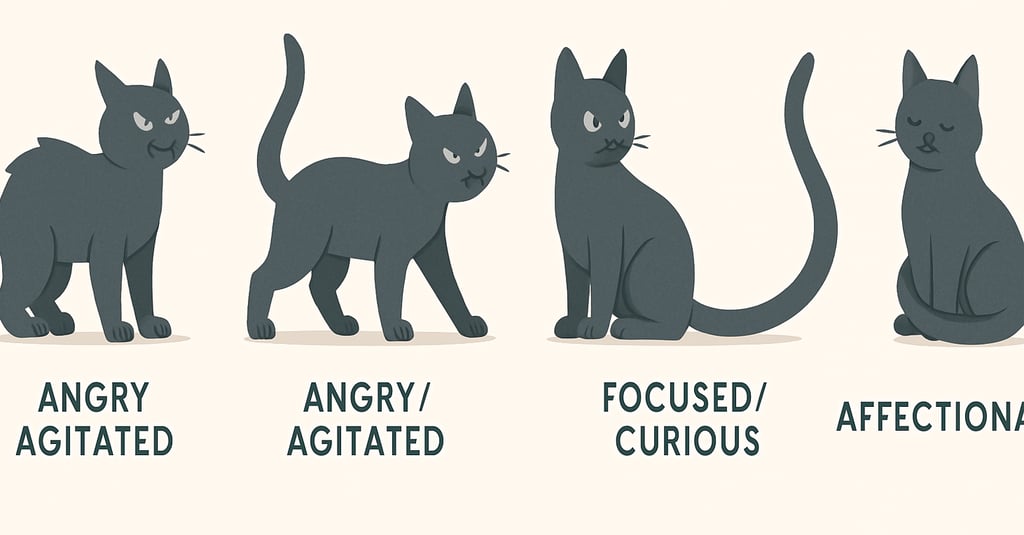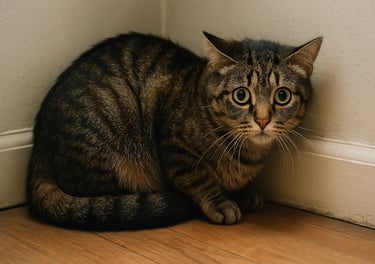What Your Cat's Tail is Really Telling You: A Visual Guide
UNDERSTANDING YOUR MYSTERIOUS FELINE


Cats are masters of subtle communication, and their tails are one of the most expressive tools in their repertoire. A flick, a twitch, or a confident upright posture can convey a wealth of information about your feline friend’s mood, intentions, and emotional state. Learning to interpret these tail signals can significantly deepen your understanding of your cat and strengthen the bond you share. This visual guide will help you decode the common messages your cat is sending with their eloquent appendage, ensuring you can better respond to their needs and appreciate their nuanced language
The Basics of Feline Tail Talk
Before diving into specific postures, it's important to remember that tail signals should always be interpreted in context with other body language cues, such as ear position, whisker placement, vocalizations, and overall body posture. A tail movement alone might be ambiguous, but when combined with other signals, the message becomes much clearer. Environmental factors and the cat's individual personality also play a role. However, there are some generally accepted interpretations of common tail positions and movements that provide a fantastic starting point for understanding your cat.
Decoding Common Tail Positions and Movements
Let's explore some of the most frequently observed tail signals and what they typically mean:
1. Tail Held High and Upright
Appearance: The tail is held straight up, often with a slight confident curve at the very tip, sometimes resembling a question mark.
Meaning: This is generally a sign of a happy, confident, and friendly cat. When your cat approaches you with their tail held high, they are expressing contentment, a willingness to interact, and a feeling of security in their environment. It’s a welcoming gesture, often seen when greeting familiar humans or other friendly cats. If the tip is quivering slightly, it can indicate a particularly happy or excited greeting.
2. Tail Held Straight Out, Parallel to the Ground
Appearance: The tail extends straight behind the cat, level with their back.
Meaning: This posture can indicate a neutral or curious mood. Your cat might be assessing a situation, feeling moderately interested, or simply relaxed but alert. It’s a common posture when they are exploring or observing something new without feeling threatened or overly excited.
3. Tail Held Low or Tucked Between the Legs
Appearance: The tail is held down towards the ground, or even curled tightly under their body and between their hind legs.
Meaning: This is a strong indicator of fear, anxiety, submission, or insecurity. A cat with a tucked tail is trying to make themselves appear smaller and less threatening. They may be feeling overwhelmed, scared by a perceived threat, or are in a submissive state. It’s crucial to give a cat showing this signal space and avoid forcing interaction, as they are clearly uncomfortable.
4. Tail Puffed Up (Bottlebrush Tail)
Appearance: The fur on the tail stands on end, making the tail appear much larger and bushier, like a bottlebrush.
Meaning: This is a defensive posture, indicating that the cat feels threatened and is trying to make themselves look bigger and more intimidating to ward off a perceived danger. It can be a sign of fear, aggression, or extreme agitation. A puffed-up tail is often accompanied by other defensive signals like hissing, growling, flattened ears, and an arched back. Approach a cat with a bottlebrush tail with extreme caution, or better yet, give them space to calm down.
5. Tail Lashing or Thrashing Vigorously from Side to Side
Appearance: The tail is moved forcefully and rapidly from side to side, often with a wide arc.
Meaning: Unlike a dog’s happy tail wag, a lashing or thrashing tail in cats usually signifies irritation, annoyance, anger, or frustration. The more vigorous the lashing, the more agitated the cat is likely to be. This can be a warning sign that the cat is reaching their limit and may become aggressive if the source of irritation continues. It’s often seen during an unwanted interaction or when they are conflicted or highly aroused, such as before a pounce during play or a fight.
6. Slow, Gentle Swish or Wave from Side to Side
Appearance: The tail moves slowly and gracefully from one side to the other, often when the cat is focused on something.
Meaning: This can indicate focused attention or mild interest, often seen when a cat is watching birds outside a window, stalking a toy, or contemplating their next move. It can also be a sign of mild indecision or a precursor to play. It’s generally a more relaxed movement than the aggressive lashing.
7. Tail Twitching at the Tip
Appearance: Only the very end of the tail twitches or flicks.
Meaning: This subtle movement can have several meanings depending on the context. It can indicate mild irritation or annoyance, especially if the cat is otherwise still. It can also signal concentration and focus, particularly during hunting or playful stalking. Sometimes, it’s a sign of curiosity or a slight alertness to something in the environment.
8. The Tail Wrap
Appearance: The cat wraps its tail around its own body when sitting or lying down, or around the legs or body of a human or another friendly animal.
Meaning: When a cat wraps its tail around itself, it can be a sign of contentment, relaxation, and feeling secure. If they wrap their tail around you or another pet, it’s a gesture of affection, companionship, and bonding – similar to a friendly hug. It shows trust and a desire for closeness.
Observing the Whole Cat
Understanding your cat's tail language is a valuable skill, but it's most effective when you consider the entire picture. Pay attention to their ears (forward and alert, flattened in fear, or swiveling to catch sounds), their eyes (dilated pupils can mean fear or excitement, slow blinks indicate trust), their whiskers (relaxed and forward, or flattened against the face in fear), and their vocalizations (purrs, meows, hisses, growls).
By becoming a keen observer of your cat’s body language, including their expressive tail, you can better understand their emotional world, anticipate their needs, and respond in ways that foster a trusting and harmonious relationship. This deeper connection not only enriches your life but also ensures your feline companion feels understood, safe, and loved.
Want to become a true expert in feline communication and understand every meow, purr, and flick of the tail? Our comprehensive guide, "Decoding Your Cat: A Guide to Feline Behavior & Communication," delves into all aspects of how cats express themselves, helping you build an even stronger bond with your mysterious feline. Unlock the secrets today!






